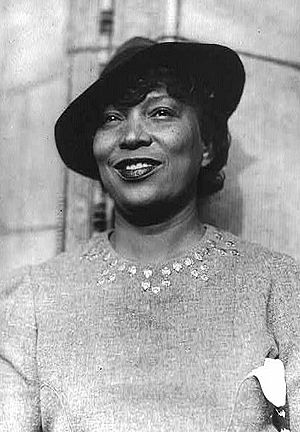Zora Neale Hurston facts for kids
Quick facts for kids
Zora Neale Hurston
|
|
|---|---|
 |
|
| Born | January 7, 1891 Notasulga, Alabama, U.S. |
| Died | January 28, 1960 (aged 69) Fort Pierce, Florida, U.S. |
| Occupation | Folklorist, anthropologist, ethnographer, novelist, short story writer, filmmaker |
| Alma mater | |
| Period | c. 1925–1950 |
| Literary movement | The Harlem Renaissance |
| Notable works | Their Eyes Were Watching God |
| Spouse |
Herbert Sheen
(m. 1927; div. 1931)Albert Price
(m. 1939; div. 1943)James Howell Pitts
(m. 1944; div. 1944) |
| Signature | |
| Website | |
| Instagram: @zoranealehurstontrust | |
Zora Neale Hurston (born January 7, 1891 – died January 28, 1960) was an American writer, anthropologist, and filmmaker. She wrote about the lives of African Americans in the early 1900s. Her stories often showed the struggles people faced in the American South. Zora also studied and wrote about hoodoo, which is a spiritual practice.
Her most famous novel is Their Eyes Were Watching God, published in 1937. She also wrote many short stories, plays, and essays. Zora Neale Hurston was an important voice in American literature.
Contents
About Zora Neale Hurston
Her Early Life and Education
Zora Neale Hurston was the fifth of eight children. Her parents were John Hurston and Lucy Ann Hurston. All four of her grandparents had been born into slavery. Her father was a Baptist preacher and a sharecropper. This means he farmed land owned by someone else and paid rent with a share of his crops. Her mother was a school teacher.
Zora was born in Notasulga, Alabama, on January 7, 1891. Her father grew up there, and her grandfather was a preacher at a local church. When Zora was three years old, her family moved to Eatonville, Florida.
Growing Up in Eatonville
Eatonville was special because it was one of the first all-black towns in the United States. It was started in 1887. Zora felt that Eatonville was her true "home." She sometimes even said she was born there. Her father was elected mayor of the town in 1897. He also became the minister of its biggest church.
Zora often used Eatonville as a setting in her stories. It was a place where African Americans could live freely. They could be independent from white society. In 1901, some teachers from the North visited Eatonville. They gave Zora several books. These books opened her mind to the world of literature. She later said this moment felt like a new "birth" for her. Zora described growing up in Eatonville in her 1928 essay, "How It Feels To Be Colored Me".
Starting Her Studies Again
In 1917, Zora went back to school. She attended Morgan College in Baltimore, Maryland. This was a historically black college. To get a free high-school education, Zora changed her birth year to 1901. She graduated from Morgan State University in 1918.
College Years and Anthropology
In 1918, Zora began studying at Howard University in Washington, DC. This was another important historically black college. She was one of the first members of Zeta Phi Beta, a sorority for black women. She also helped start The Hilltop, the university's student newspaper. Zora studied Spanish, English, Greek, and public speaking. She earned a degree in 1920.
In 1925, Zora received a scholarship to Barnard College at Columbia University. She was the only black student there. At Barnard, she studied ethnography with a famous anthropologist named Franz Boas. Ethnography is the study of different cultures and peoples. She also worked with other well-known anthropologists. Zora earned her bachelor's degree in anthropology in 1928.
After college, Zora continued her anthropology studies at Columbia University. She became friends with many writers in Harlem, New York. Her apartment was a popular place for social gatherings. Zora also won awards for her short stories and plays. These were published in magazines like Opportunity: A Journal of Negro Life.
Her Career as a Writer and Researcher
Early in her career, Zora Neale Hurston did a lot of research. She studied African-American and Caribbean folklore. Folklore includes the traditions, stories, and beliefs of a community. She was interested in how these traditions shaped people's identities.
Zora also wrote fiction about issues in the black community. She became a key figure in the Harlem Renaissance. This was a time when African-American art, music, and literature flourished. Her short stories were published in important collections.
After moving back to Florida, Zora wrote many books. She published Mules and Men (1935), which was a collection of African-American folktales. She also wrote her first three novels: Jonah's Gourd Vine (1934), Their Eyes Were Watching God (1937), and Moses, Man of the Mountain (1939). In 1938, she published Tell My Horse. This book shared her research on rituals in Jamaica and Haiti.
Zora Neale Hurston's books explored the African-American experience. They also showed the challenges she faced as an African-American woman. For many years, her novels were not widely recognized. However, interest in her work grew in 1975. This happened after author Alice Walker wrote an article about her.
Some of Zora's works were published after her death. Every Tongue Got to Confess (2001) is a collection of folktales she gathered. Barracoon: The Story of the Last "Black Cargo" (2018) tells the story of Cudjoe Lewis. He was one of the last known survivors of the transatlantic slave trade.
Her Marriages
Zora Neale Hurston was married a few times during her life. In 1927, she married Herbert Sheen, a jazz musician. Their marriage ended in 1931. Later, in 1939, she married Albert Price. This marriage also ended after a few months. In 1944, Zora married James Howell Pitts. This marriage lasted less than a year.
Images for kids
-
Zora Neale Hurston, photo by Carl Van Vechten (1938)
See also
 In Spanish: Zora Neale Hurston para niños
In Spanish: Zora Neale Hurston para niños



